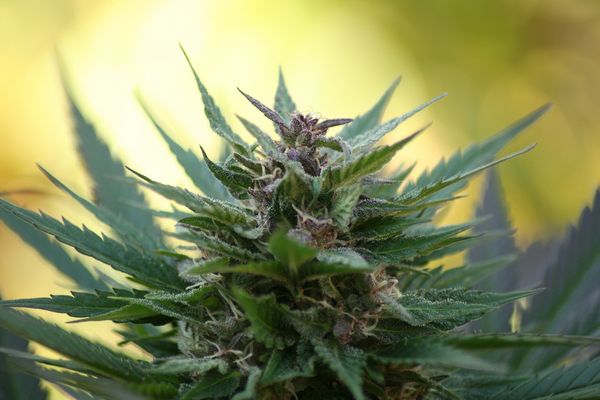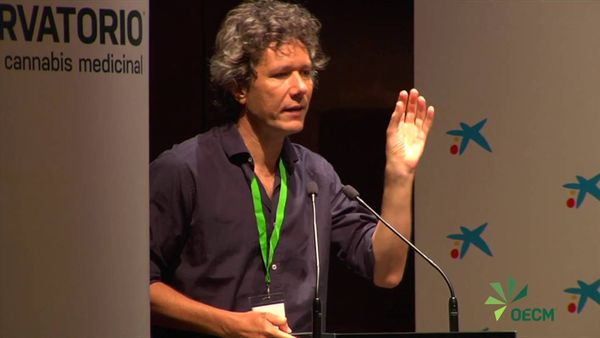- On 20 September we had the chance to attend the official presentation of the Spanish Medical Cannabis Observatory, an entity that aims to pave the way in Spain towards a new therapeutic cannabis model while promoting research and its application to the field of Medicine.
- At the presentation of this project, which took place at the Caixa Fórum in Madrid, we were able to attend various presentations given by scientists and researchers in the field, including Manuel Guzmán, a Professor of Biochemistry and Molecular Biology at the Complutense University of Madrid and a member the Royal Academy of Pharmacy, who offered a brief introduction to cannabinoids.

Cannabinoids are substances present in the composition of Cannabis Sativa and whose properties can be exploited medical field. To understand why cannabis is effective in the treatment of different diseases and how it affects the body it is important to comprehend the mechanisms and agents involved in these processes.
Manuel Guzmán, who forms part of the Spanish Medical Cannabis Observatory, wished to underscore in his remarks the importance of identifying the main active components of cannabis, including THC, a substance known for decades thanks to the studies carried out by Raphael Mechoulam.
Much more than THC ...
While it is the best known substance, THC is not the only active ingredient of the cannabis plant. Rather, it is accompanied by more than 100 different cannabinoids, and other elements, such as terpenes and flavonoids. As Guzmán observed, although the pharmacology of many of them is not yet known, the second most important bioactive agent must be highlighted: THC's "twin brother" at the molecular level: cannabidiol, also known as CBD.
If we observe the molecular formula of cannabidiol and compare it to that of THC, we find that their resemblance is remarkable. Although similar, the two formulas are not the same, however, and those small differences are what make the effects of each substance so very different.
In this regard Manuel Guzmán gave a brief presentation on the medical properties of CBD, a cannabinoid that is currently in the spotlight and offers the following benefits at the medical level:
- It has anti-inflammatory properties
- It has anticonvulsant effects
- It is a potent neuroprotective agent
- It helps fight spasticity, so it is especially indicated for people who suffer from Multiple Sclerosis.
- It is antiemetic, i.e., it helps to suppress nausea, which is especially useful for people who are receiving chemotherapy treatments.
CBD also improves THC toleration, as it counteracts some of its unwanted side effects, like dry mouth, tachycardia, and, above all, psychoactive effects, especially important when we are talking about its medical use. This is why in some therapies with medical cannabis, it is recommended that CBD be administered along with THC.
How do cannabinoids affect our bodies?
As Manuel Guzmán explained, the seminal work by Raphael Mechoulam in the 60s explaining the chemical composition of cannabis was essential to laying the foundations for research on this plant, not only in pharmacological terms, but also to design derivatives of cannabinoids that made it possible to understand how they work.
Approximately 30 years after Mechoulam and his team described these compounds, there was a paradigm shift in the perception of how these substances affect the body. The discovery of the endocannabinoid system in the 90s revealed that there exist in some of our cells (our neurons, for example) molecules that specifically bind the cannabinoids to our systems.
Cannabinoids, along with the active ingredients of any other drug, do not function magically, but rather by attaching to these molecules, which recognise them and receive them in the organism: receptors. In this case cannabinoid receptors, as molecules located on the surface of our cells (for example, the neurons of the central nervous system), are capable of specifically recognising the components of cannabis, such as THC. This makes the cannabinoid in question, when received by the agent that identifies it, bind to the cell with a very high degree of specificity.
To better understand this process we could use the analogy of a key and a lock. The cannabinoid, which would be the "key," specifically binds to its receptor, its "molecular lock." Therefore, only cells that have these locks will be sensitive to the cannabinoid, and only this agreement will trigger a response in the cell, which will change its activity or inhibit it, depending on the type of signal received.
Discovering the endocannabinoid system
There are two types of "locks" in our bodies: CB1 receptors, appearing mainly in the nervous system; and CB2 receptors, related to the immune system, thus mediating in anti-inflammatory effects.
Before learning that the human body itself produces cannabinoids, it seemed like a quirk of nature that cannabinoids were only produced by one plant amongst the some 300,000 comprising the plant kingdom. The question that, logically, was generated by the discovery of these receptors was "Why do these receptors exist in our bodies?" The initial hypothesis was that these receptors must be located in our cells to bind chemically very similar cells to cannabinoids, molecules that we living things produce and that attach to those receptors, modulating the activity of certain neuronal circuits.
This hypothesis, which Raphael Mechoulam operated on, led to the discovery of endogenous cannabinoids, or endocannabinoids, which are molecules similar to phytocannabinoids (those produced by the plant), produced by the brains of all vertebrate animals. Cannabinoids, therefore, act on our bodies by mimicking the action of these endocannabinoids, produced by our organism to control various processes.
What are these processes and how are they important to our bodies?
As we mentioned earlier, cannabinoids affect different functions and processes of our system through their attachment to the CB1 and CB2 receptors. To illustrate these processes more clearly, Guzmán explained the reactions in our system caused by THC:
- Impact on motor skills and coordination: occurs when THC binds to cannabinoid receptors located in brain areas responsible for these functions, like the basal ganglia.
- Increased appetite: occurs due to the binding of THC to receptors located in the hypothalamus.
- Impairment of cognitive processes: several studies indicate that THC affects cognitive processes, such as memory, through it interaction with receptors in the cortex of the hypothalamus.
- Inhibition of nausea: occurs through THC's interaction with cannaboid receptors located in centres of our nervous systems responsible for inhibiting vomiting.
Guzmán came up with an explanation helping us to understand how cannabinoids affect our bodies. In the wake of Raphael Mechoulam's studies, over the last 50 years a basic conceptual framework has been developed to understand at least why plant cannabinoids act on some processes in the body and not on others. From this point it has been possible to design, equipped with more knowledge, cannabinoid therapies that help to improve many patients' quality of life.

What therapeutic benefits does cannabinoids' interaction offer?
Manuel Guzmán noted that the term "therapeutic" does not mean that a substance is good or bad, which depends on each specific case. For example, an athlete who must run the 400 meters in the Olympics is not interested in suppressing his motor system by using cannabis. However, if a person suffers from a hyperkinetic defect, such as the inadvertent activation of his motor system, as is the case with those affected by some neurodegenerative disorders that cause involuntary spasms, he will, obviously, be interested in reducing his motor system's activity.
Cannabinoids as drugs
Several studies have demonstrated that cannabinoids can be important elements in the medical field thanks to their multiple, highly beneficial properties in the treatment of certain diseases. Below we briefly indicate the most noteworthy properties of some cannabinoids:
- Analgesic: very important for patients suffering from chronic and neuropathic pain.
- Anti-spasticity: useful for the treatment of disorders associated with neurodegenerative conditions, such as Multiple Sclerosis.
- Anti-emetic: useful for alleviating the side effects of chemotherapy.
- Anti-convulsive: very effective in some cases of epilepsy, such as Dravet's syndrome.
- Neuroprotective: effective for the treatment of neurodegenerative diseases, such as Alzheimer's.
Once it was verified that cannabinoids possess properties applicable to the field of Medicine, the next question was: Is it feasible to use cannabinoids as drugs? As Guzmán noted, there are a number of parameters that define how effective and safe a drug is. With cannabinoids, as with any other medication, we must strike a "therapeutic balance;" that is, not only focus on its therapeutic effects, but also assess its adverse effects.
The good news is that everything indicates that one of cannabinoids' advantages is that they lack any serious side effects. Several scientific studies have shown that the metabolism of cannabinoids is slow, as they are substances that struggle to enter and spread throughout the bodies, spending several days in them. Although they are not harmless substances, and they can have some adverse effects, such as the impairment of cognitive processes, cannabinoids are compounds devoid of acute toxicity, because the receptors are not located in centres playing a critical role in the contraction of the diaphragm during cardiac contraction, such that there is no risk of cardiac arrest or alterations in basic vital parameters.
The only drawback with treatments requiring the use of THC is that it does entail a psychoactive effect, which may be a plus for some people at the recreational level, but can be a problem for patients who need to take medical cannabis daily, and for a long time.
Evaluating the therapeutic balance of cannabinoids
In his presentation Manuel Guzmán stated that cannabinoids may be used, at least, as palliative drugs in the treatment of different diseases, and that today there are already many patients benefitting from their properties.
The idea is to use cannabis, adapting it to the specific needs of each patient
The scientist conceded that in terms of efficacy there are traditional medicines that work better than cannabinoids against certain disorders and diseases, but pointed out that it is necessary to seriously consider whether they are ultimately worth it, given their serious side effects. Benzodiazepines, for example, are more effective in the reduction of anxiety disorders than some cannabinoids, such as CBD, but their long-term side effects are much more severe.
Guzmán said that this is a reality and that cannabinoids should find their place: "The idea is to use cannabis, adapting it to the specific needs of each patient, whether as an alternative medicine or a supplement. In this regard we must consider that the therapeutic balance of cannabinoids is very good. Its effectiveness may be moderate, but its side effects are perfectly tolerable, much more so than with other therapies".
As the professor said, cannabinoids could be an excellent option as a replacement therapy in some cases in which the patient does not tolerate standard medication, does not respond well to the drug, or, after prolonged use, has developed a high tolerance to it.
This is what we call combined therapy, with cannabinoids complementing the action of other drugs known today.
Guzmán explained that today the patients who are benefiting most from the therapeutic use of cannabinoids are those with diseases that have seriously damaged their quality of life: people with chronic and / or degenerative diseases.
Expanding knowledge of the cannabis plant's different compounds seems to be the key for its therapeutic optimisation. Although in Spain this process seems to be moving forward very slowly, organisations like the Spanish Medical Cannabis Observatory, and professionals like Manuel Guzmán, are making it possible for the Spanish health system and thousands of patients to benefit from the medical properties of cannabis in the future.
How to administer / consume cannabinoids
As Guzmán said, the active ingredients of cannabis can be obtained from the plant itself, as well as its derivatives (oils, extracts), which are important sources of cannabinoids. Cannabinoids also dissolve poorly in aqueous solvents, but very well in organic or fatty ones, such that in many cases they appear in oils.
There are currently some drugs on the market that have been approved by various regulatory agencies and that contain more or less raw extracts of the plant, or synthetic cannabinoids:
- Sativex
- Pure compounds: THC capsules
- Cesamet: a synthetic derivative of THC
- Epidiolex: a preparation of CBD
- Marinol: synthetic THC
According to Guzmán the next question to be addressed is the effectiveness of mixtures of compounds as opposed to the use of pure compounds. In general, today tolerability and, in many cases, therapeutic effects, are better when different cannabinoids with complementary effects are combined. In some cases certain cannabinoids, like CBD, can mitigate the unwanted effects of other cannabinoids, like THC.



Comments from our readers
Read comments in other languages:
Did you like this post?
Your opinion about our seeds is very important to us and can help other users a lot (your email address won't be made public).